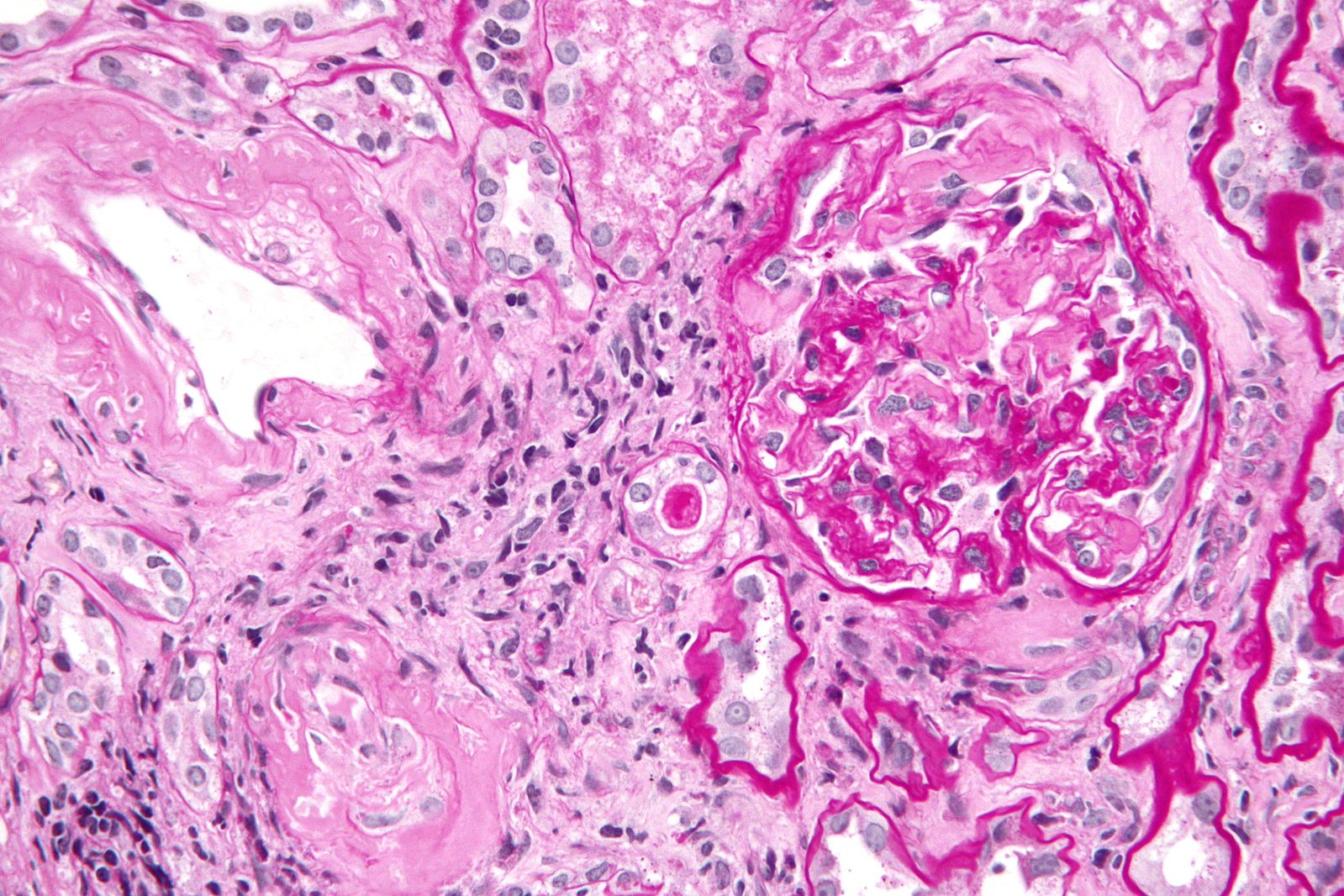Difference Between Amyloidosis and Sarcoidosis
Amyloidosis is when amyloid proteins accumulate in the tissues and organs of the body. Sarcoidosis is when inflamed tissue called granulomas accumulates in the lymph nodes and lungs of the body.

What is Amyloidosis?
Definition:
Amyloidosis is the condition in which there is an accumulation of an unusual protein in the tissues of the body.
Causes:
Several diseases including TB, ulcers, abdominal infections, and leprosy, are associated with the development of amyloidosis. In other cases, certain gene mutations and inherited inflammatory conditions are thought to be responsible for a person developing amyloid deposits in the organs.
Diagnosis:
The diagnosis of amyloidosis is made by looking for amyloid fibrils. These fibrils can be seen in tissues removed from organs by a biopsy. The amyloid deposits give a specific birefringence when stained with congo red dye. Immunohistochemistry and immunofluorescence methods have to be used if the exact type of amyloid that is being deposited, is to be determined.
Symptoms:
There may be only a few symptoms or none at all depending on how many amyloid deposits there are and where they are found in the body. If amyloid is deposited in the heart or kidneys then symptoms typical of kidney or heart failure may become evident. Symptoms can include pain, shortness of breath, swollen ankles, and skin rashes.
Treatment:
Treatment depends on the type of amyloidosis and often takes the form of supportive care. For instance, a person with kidney problems may need to adjust their diet and be prescribed medication such as loop diuretics to help kidney function. A person with heart problems due to amyloidosis can be given medications such as calcium channel blockers to help heart function.

What is Sarcoidosis?
Definition:
Sarcoidosis is a condition in which granulomas occur in the lungs and lymphatic system, and occasionally in other organs as well.
Causes:
Sarcoidosis is an inflammatory condition, which results in the production of lumps of inflamed tissue in the lungs and lymph nodes of the body.
Diagnosis:
The diagnosis of sarcoidosis can be done using chest X-ray and a biopsy of the abnormal tissue. An endobronchial ultrasound–guided transbronchial needle aspiration (EBUS-TBNA) works well for biopsy of the lymph nodes in the lung. This has a 90% accuracy rate. Lymph nodes in other parts of the body can be biopsied where granulomas are evident.
Symptoms:
Symptoms of sarcoidosis include lung crackles and shortness of breath. There is also a feeling of general fatigue and fever. The condition can cause eye problems, and affect the bone marrow, liver, and lymph nodes. The illness is chronic in 1/3 of patients and is fatal in about 1% to 5% of people.
Treatment:
Treatment of sarcoidosis includes using medication such as immunosuppressants and corticosteroids. Other medications such as nonsteroidal anti-inflammatory medicine (NSAIDS), can help treat the pain the illness causes.
Difference between Amyloidosis and Sarcoidosis
Definition
Amyloidosis is the disorder where there is an accumulation of an unusual protein in the tissues of the body. Sarcoidosis is the disorder in which granulomas occur in the lungs and lymphatic system, and occasionally in other organs as well.
Age of diagnosis
The age when amyloidosis is most often diagnosed is in middle-age, between 50 and 65 years. Sarcoidosis is mostly diagnosed in young adults who are between 20 to 40 years of age.
Causes
Amyloidosis is caused by illnesses such as TB, as well as ulcers, abdominal infections, leprosy, inherited mutations, and inflammation. Sarcoidosis is caused by an inflammatory response in the body.
Symptoms
Symptoms of amyloidosis include pain, shortness of breath, swollen ankles, and skin rashes. Symptoms of sarcoidosis include shortness of breath, lung crackles, swollen lymph nodes, and night sweats.
Treatment
Treatment options for amyloidosis depends on which organ is affected. Loop diuretics are used if the kidney is impacted or else calcium channel blockers are used when the heart is affected. Treatment options for sarcoidosis include the use of NSAIDs, corticosteroids, and immunosuppressants.
Table comparing Amyloidosis and Sarcoidosis

Summary of Amyloidosis Vs. Sarcoidosis
- Amyloidosis and sarcoidosis are both conditions that can result in abnormal deposits of substances in tissues.
- Amyloidosis occurs in middle-aged and older people.
- Sarcoidosis occurs in younger people compared to amyloidosis.
FAQ
Can sarcoidosis cause amyloidosis?
Sarcoidosis only very rarely leads to amyloidosis. A case was reported in a person who had a heart transplant. They developed sarcoidosis which resulted in amyloid deposits and sarcoid granulomas were found in multiple organs.
Is amyloidosis the same as sarcoidosis?
Amyloidosis is not the same as sarcoidosis. Amyloidosis involves amyloid deposits and sarcoidosis involves granuloma deposits.
How long can you live with cardiac sarcoidosis?
Results indicate a range of survival times for cardiac sarcoidosis ranging from 2 years to about 5 years.
What is cardiac amyloidosis?
Cardiac amyloidosis specifically involves the heart and is when amyloid deposits build up in the muscle of the heart, affecting its function.
- Difference Between Rumination and Regurgitation - June 13, 2024
- Difference Between Pyelectasis and Hydronephrosis - June 4, 2024
- Difference Between Cellulitis and Erysipelas - June 1, 2024
Search DifferenceBetween.net :
Leave a Response
References :
[0]John L. Berk, and Sanchorawala, V. “Amyloidosis”. Merck Manual, 2021, https://www.msdmanuals.com/professional/endocrine-and-metabolic-disorders/amyloidosis/amyloidosis
[1]Brunger, Anne Floor, et al. "Causes of AA amyloidosis: a systematic review." Amyloid 27.1 (2020): 1-12.
[2]Michael C. Iannuzzi, and Sah, B.P. “Sarcoidosis”. Merck Manual, 2021, https://www.msdmanuals.com/professional/pulmonary-disorders/sarcoidosis/sarcoidosis
[3]Image credit: https://commons.wikimedia.org/wiki/File:Sarcoidosis_-_Asteroid_bodies_2.jpg
[4]Image credit: https://commons.wikimedia.org/wiki/File:Renal_amyloidosis_-_very_high_mag.jpg
